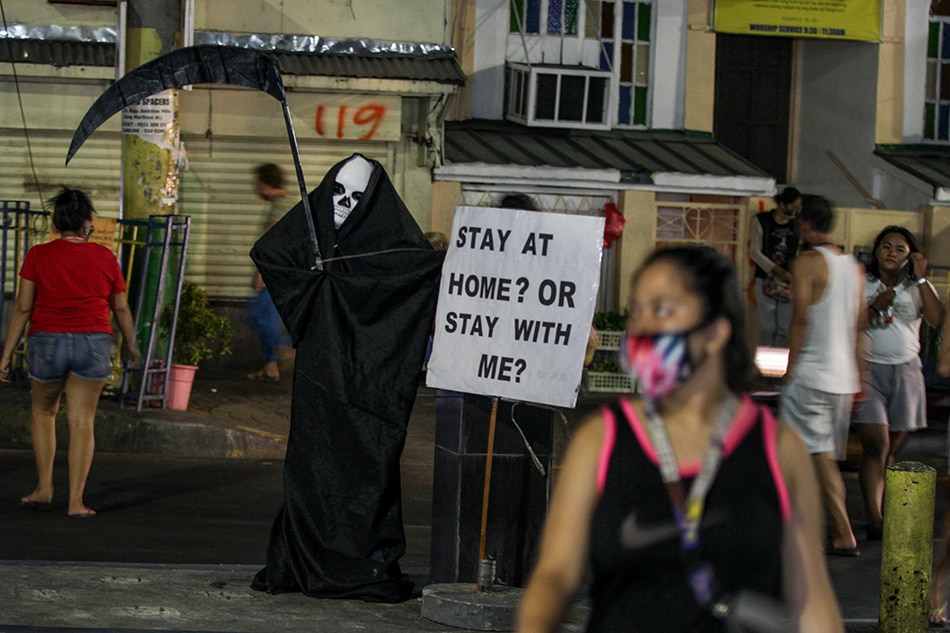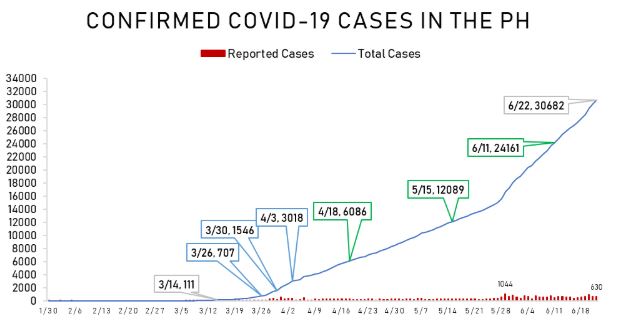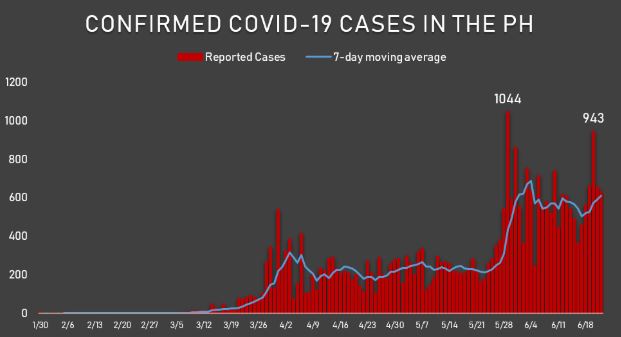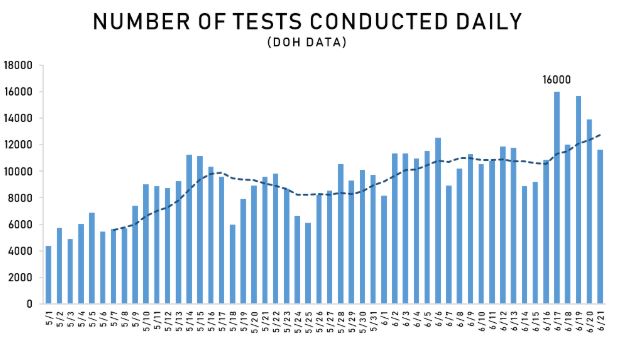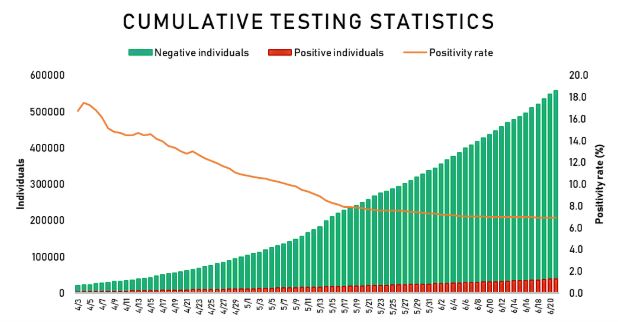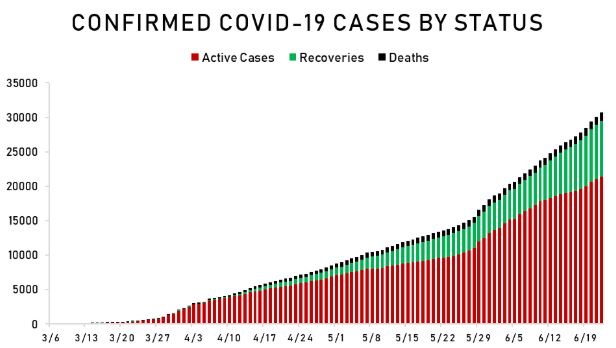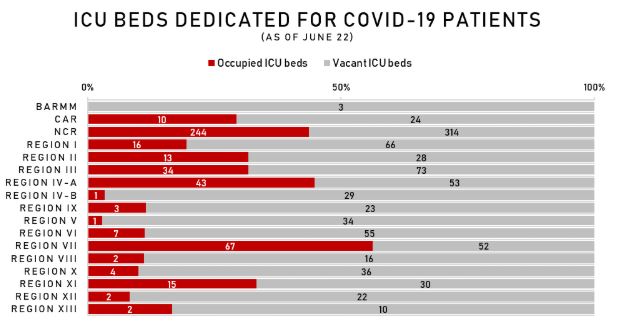After 100 days of lockdown, PH is still far from beating COVID-19 | ABS-CBN

Welcome, Kapamilya! We use cookies to improve your browsing experience. Continuing to use this site means you agree to our use of cookies. Tell me more!
After 100 days of lockdown, PH is still far from beating COVID-19
After 100 days of lockdown, PH is still far from beating COVID-19
Warren de Guzman and Edson Guido,
ABS-CBN Data Analytics
Published Jun 23, 2020 07:02 PM PHT
MANILA -- On March 15, the Philippines started what would become the longest community quarantine in the world, in an effort to contain a COVID-19 outbreak that was still in its early stages. The hope was the lockdown would prevent newly discovered cases in the National Capital Region (NCR) from spreading to other parts of Luzon and beyond. It was a strategy that would be adopted globally, keep people at home to limit the opportunity for viral transmission.
MANILA -- On March 15, the Philippines started what would become the longest community quarantine in the world, in an effort to contain a COVID-19 outbreak that was still in its early stages. The hope was the lockdown would prevent newly discovered cases in the National Capital Region (NCR) from spreading to other parts of Luzon and beyond. It was a strategy that would be adopted globally, keep people at home to limit the opportunity for viral transmission.
But the number of COVID-19 cases still rose. From 111 cases on March 14, it hit 707 on March 26. It doubled to 1,546 on March 30. It doubled again on April 3 to 3,018. Alarmingly, It was doubling every four days. But then, it slowed down. It would be another 15 days before the total doubled again to 6,086 on April 18. By then, the lockdown had run for over a month. Government would argue this was evidence that the lockdown was working.
But the number of COVID-19 cases still rose. From 111 cases on March 14, it hit 707 on March 26. It doubled to 1,546 on March 30. It doubled again on April 3 to 3,018. Alarmingly, It was doubling every four days. But then, it slowed down. It would be another 15 days before the total doubled again to 6,086 on April 18. By then, the lockdown had run for over a month. Government would argue this was evidence that the lockdown was working.
On May 15, total COVID-19 cases would hit 12,089, about a month after the last time the number doubled. By June 11, it would double again to 24,161. The rate of doubling seems to be increasing again, coinciding with the easing of lockdown conditions from enhanced community quarantine (ECQ) down to general community quarantine (GCQ). Now the total is over 30,000. The increasingly steep line graph of total cases says a lot.
On May 15, total COVID-19 cases would hit 12,089, about a month after the last time the number doubled. By June 11, it would double again to 24,161. The rate of doubling seems to be increasing again, coinciding with the easing of lockdown conditions from enhanced community quarantine (ECQ) down to general community quarantine (GCQ). Now the total is over 30,000. The increasingly steep line graph of total cases says a lot.
In this chart, the blue line shows the 7-day moving average of reported cases per day. That’s a better measure of the direction of the so-called COVID-19 curve, compared to the more volatile red bar graph, which shows daily reported cases. Again, the number of reported cases surged in the early days of the Philippine lockdown, before dipping in early April, coinciding with the 14 day gestation period for the virus. This appeared to show the quarantine had accomplished its job and arrested the rise in COVID-19 cases. But after the government decided to ease lockdown conditions in different parts of Luzon, based on the number of cases found in each area, the daily reported cases began to rise. It's first seen moving up incrementally in late April, before shooting up in late May. The start of the ascent of the line is about 14 days or so after the move to the lighter modified enhanced community quarantine for NCR on May 16. Backlogs from previous months were also addressed, resulting in the highest number of reported cases on May 29.
In this chart, the blue line shows the 7-day moving average of reported cases per day. That’s a better measure of the direction of the so-called COVID-19 curve, compared to the more volatile red bar graph, which shows daily reported cases. Again, the number of reported cases surged in the early days of the Philippine lockdown, before dipping in early April, coinciding with the 14 day gestation period for the virus. This appeared to show the quarantine had accomplished its job and arrested the rise in COVID-19 cases. But after the government decided to ease lockdown conditions in different parts of Luzon, based on the number of cases found in each area, the daily reported cases began to rise. It's first seen moving up incrementally in late April, before shooting up in late May. The start of the ascent of the line is about 14 days or so after the move to the lighter modified enhanced community quarantine for NCR on May 16. Backlogs from previous months were also addressed, resulting in the highest number of reported cases on May 29.
ADVERTISEMENT
Obviously, more people out and about created more opportunities for the transmission of COVID-19. Overall, more new COVID-19 cases are confirmed every day, compared to the start of the quarantine.
Obviously, more people out and about created more opportunities for the transmission of COVID-19. Overall, more new COVID-19 cases are confirmed every day, compared to the start of the quarantine.
The increase in cases however can be partly attributed to increased testing, as shown in this chart. On June 17, 16,000 COVID-19 tests were conducted. On June 19, 15,679 tests were done. Daily tests are finally gaining momentum toward the 30,000-a-day goal, half a month after the original target for that total, at the end of May. While this is yielding more positive results, it is also providing the government with more information, much needed in its decision- making process ahead of the end of June, when President Rodrigo Duterte will decide on either extending, lowering, or raising current quarantine conditions.
The increase in cases however can be partly attributed to increased testing, as shown in this chart. On June 17, 16,000 COVID-19 tests were conducted. On June 19, 15,679 tests were done. Daily tests are finally gaining momentum toward the 30,000-a-day goal, half a month after the original target for that total, at the end of May. While this is yielding more positive results, it is also providing the government with more information, much needed in its decision- making process ahead of the end of June, when President Rodrigo Duterte will decide on either extending, lowering, or raising current quarantine conditions.
The positivity rate, or the number of positive cases relative to the number of individuals tested, is shown here by the yellow line. It is going down. That is a good thing. Despite more individuals being tested, less and less people are actually testing positive for COVID-19. From the high teens in April, it is now at around 7%, meaning 7 out of every 100 people tested are positive for the dreaded viral disease. The goal is to get it lower, say around 5%, and to sustain it at that level for half a month, again the gestation period for the virus. If that is achieved, it would mean the spread of COVID-19 is slowing.
The positivity rate, or the number of positive cases relative to the number of individuals tested, is shown here by the yellow line. It is going down. That is a good thing. Despite more individuals being tested, less and less people are actually testing positive for COVID-19. From the high teens in April, it is now at around 7%, meaning 7 out of every 100 people tested are positive for the dreaded viral disease. The goal is to get it lower, say around 5%, and to sustain it at that level for half a month, again the gestation period for the virus. If that is achieved, it would mean the spread of COVID-19 is slowing.
This chart shows recoveries, in green, are accelerating and outpacing total deaths due to COVID-19, shown in black. That’s another positive trend. However the total number of recoveries and deaths is just about a third of the total confirmed cases of 30,000. That means there is a lag in the data collection for recoveries and deaths. We’ll see if this trend holds true once more information is available.
This chart shows recoveries, in green, are accelerating and outpacing total deaths due to COVID-19, shown in black. That’s another positive trend. However the total number of recoveries and deaths is just about a third of the total confirmed cases of 30,000. That means there is a lag in the data collection for recoveries and deaths. We’ll see if this trend holds true once more information is available.
The quarantine however was meant to do more than just slow the transmission of COVID-19. It was also meant to buy time for the Philippines to prepare for more COVID-19 cases, especially since a vaccine for the virus has yet to be discovered. Ideally, the government should have used the time bought by the world’s longest lockdown to invest in healthcare. But data from a civil society initiative called the Citizen’s Budget Tracker show government has only spent a little over P200 billion for the entire Philippine COVID-19 response, with the majority of the spending going to social amelioration. There were billions of pesos set aside for the purchase of equipment such as masks and other personal protective gear and ventilators. But right now, there is not enough data to fully account for what was spent, and where it went.
The quarantine however was meant to do more than just slow the transmission of COVID-19. It was also meant to buy time for the Philippines to prepare for more COVID-19 cases, especially since a vaccine for the virus has yet to be discovered. Ideally, the government should have used the time bought by the world’s longest lockdown to invest in healthcare. But data from a civil society initiative called the Citizen’s Budget Tracker show government has only spent a little over P200 billion for the entire Philippine COVID-19 response, with the majority of the spending going to social amelioration. There were billions of pesos set aside for the purchase of equipment such as masks and other personal protective gear and ventilators. But right now, there is not enough data to fully account for what was spent, and where it went.
There is enough data for one measure of the Philippine healthcare system’s capability to handle a resurgence of COVID-19 cases-- intensive care unit (ICU) beds. This table shows the status of ICU beds set aside for COVID-19 patients. Red reflects occupied beds. Grey reflects vacant beds. As of June 22, the National Capital Region has a total of 244 occupied beds. The next highest total is 67 in Region 7, including Cebu. Region 4-A follows with 43. These are the centers of the outbreak in the Philippines.
There is enough data for one measure of the Philippine healthcare system’s capability to handle a resurgence of COVID-19 cases-- intensive care unit (ICU) beds. This table shows the status of ICU beds set aside for COVID-19 patients. Red reflects occupied beds. Grey reflects vacant beds. As of June 22, the National Capital Region has a total of 244 occupied beds. The next highest total is 67 in Region 7, including Cebu. Region 4-A follows with 43. These are the centers of the outbreak in the Philippines.
NCR, however, also has the most number of vacant beds at 314. That means occupancy is only at 44%. Region 7 has 52 vacant beds, for an occupancy rate of 56%. It is the only region with more occupancies than vacancies. Particularly worrisome is the Bangsamoro Autonomous Region in Muslim Mindanao (BARMM). It only has 3 ICU beds for COVID-19 patients. If COVID-19 spreads further there, BARMM’s healthcare system could be easily overwhelmed.
NCR, however, also has the most number of vacant beds at 314. That means occupancy is only at 44%. Region 7 has 52 vacant beds, for an occupancy rate of 56%. It is the only region with more occupancies than vacancies. Particularly worrisome is the Bangsamoro Autonomous Region in Muslim Mindanao (BARMM). It only has 3 ICU beds for COVID-19 patients. If COVID-19 spreads further there, BARMM’s healthcare system could be easily overwhelmed.
All the data taken together tell us both quarantine conditions and testing activities have an impact on the COVID-19 curve. There are some positive numbers, including ICU vacancy rates in key urban centers, as well as the recovery and positivity rates. But the numbers also show the Philippines is far from beating COVID-19, despite instituting the longest quarantine in the world at 100 days and counting.
All the data taken together tell us both quarantine conditions and testing activities have an impact on the COVID-19 curve. There are some positive numbers, including ICU vacancy rates in key urban centers, as well as the recovery and positivity rates. But the numbers also show the Philippines is far from beating COVID-19, despite instituting the longest quarantine in the world at 100 days and counting.
The Inter-Agency Task Force on COVID-19, and President Rodrigo Duterte will be studying these numbers carefully before they decide on what to do with current quarantine conditions at the end of June, next week.
The Inter-Agency Task Force on COVID-19, and President Rodrigo Duterte will be studying these numbers carefully before they decide on what to do with current quarantine conditions at the end of June, next week.
Read More:
coronavirus
COVID-19
ABS-CBN Data Analytics
Flattening the Curve
Philippines longest lockdown in the world
Lockdown
longest lockdown in the world
ADVERTISEMENT
ADVERTISEMENT


